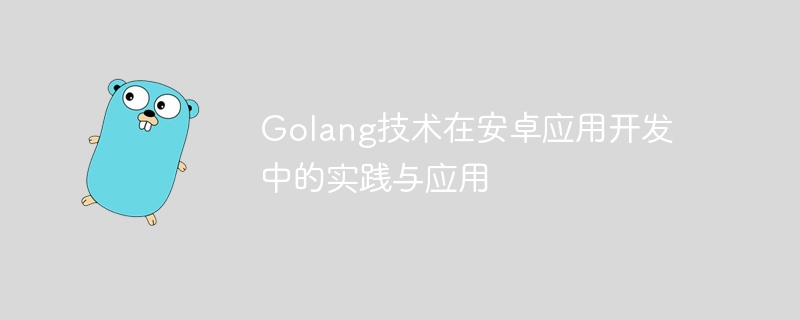Home >Backend Development >Golang >The practice and application of Golang technology in Android application development
The practice and application of Golang technology in Android application development
- 王林Original
- 2024-03-21 09:00:05950browse

The practice and application of Golang technology in Android application development
In recent years, with the rapid development of the mobile Internet, Android application development has become more and more important. In Android application development, the use of Golang technology for development has gradually become favored by developers. As an efficient and reliable programming language, Golang has the characteristics of powerful concurrency performance, simplicity and ease of use, giving it unique advantages in Android application development. This article will explore the specific application of Golang technology in Android application development from the perspective of practice and application, and provide code examples for demonstration.
1. Advantages of Golang and Android application development
- Powerful concurrency performance: Golang effectively improves the concurrency performance of the program through the concurrency model of goroutine and channel, making it possible to process a large number of More efficient when doing concurrent tasks.
- Cross-platform support: Golang has good cross-platform capabilities and can run on different operating systems through simple compilation, which provides greater flexibility for Android application development.
- The code is concise and easy to read: Golang's syntax is concise and clear, with good readability, which can reduce the amount of code and improve development efficiency.
2. Golang’s practice in Android application development
- Using Gomobile tools for Android application development
Gomobile is officially provided by Golang A tool for writing mobile applications using Golang. Through Gomobile, Golang code can be compiled into a library for the Android platform and interact with Java or Kotlin to realize the development of Android applications. Here is a simple sample code:
package main
import "fmt"
import "golang.org/x/mobile/app"
func Hello() {
fmt.Println("Hello, Golang on Android!")
}
func main() {
app.Main(func(a app.App) {
Hello()
})
}- Using Golang for network requests
In Android application development, network requests are often needed to obtain data. The Golang standard library provides the net/http package to facilitate network requests. The following is a simple network request sample code:
package main
import (
"fmt"
"net/http"
"io/ioutil"
)
func main() {
resp, err := http.Get("https://www.example.com/api/data")
if err != nil {
fmt.Println("Error:", err)
return
}
defer resp.Body.Close()
body, err := ioutil.ReadAll(resp.Body)
if err != nil {
fmt.Println("Error:", err)
return
}
fmt.Println("Response:", string(body))
}The above is a simple sample code for using Golang to make network requests, which can easily achieve data acquisition and display in Android applications.
3. Summary
In Android application development, using Golang technology has many advantages, such as powerful concurrency performance, cross-platform support, concise and easy-to-read code, etc. Through the tools and libraries provided by Golang, developers can quickly and easily develop Android applications and realize complex functional requirements. This article shows the practice and application of Golang in Android application development through specific code examples, hoping to bring some inspiration and help to readers.
The above is the detailed content of The practice and application of Golang technology in Android application development. For more information, please follow other related articles on the PHP Chinese website!

